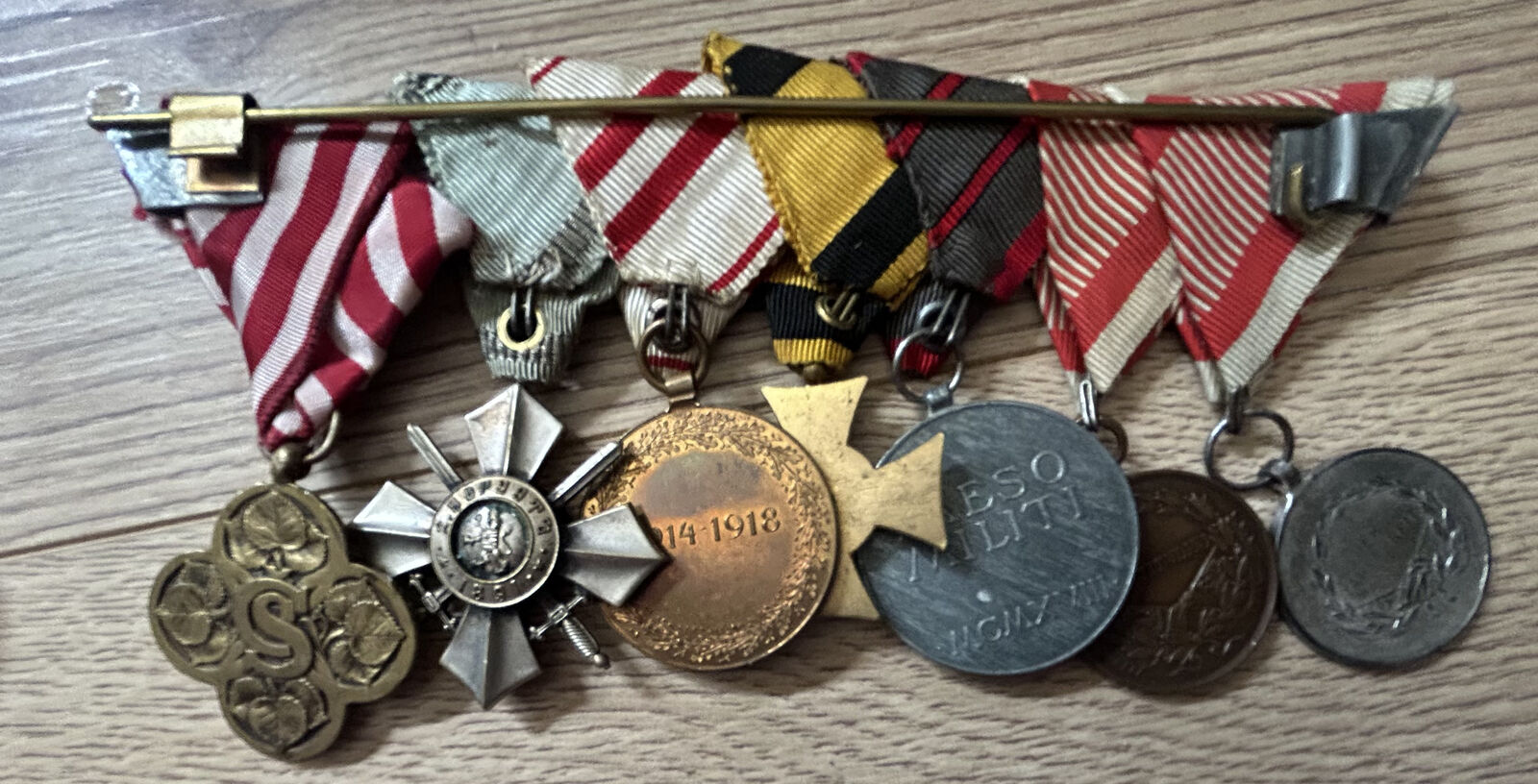
WW1 Austrian Double Bravery with Bars representing 4 awards Medal Group Genuine For Sale

When you click on links to various merchants on this site and make a purchase, this can result in this site earning a commission. Affiliate programs and affiliations include, but are not limited to, the eBay Partner Network.
WW1 Austrian Double Bravery with Bars representing 4 awards Medal Group Genuine:
$342.05
WW1 Austrian Double Bravery with Bars representing 4 awards Medal Group GenuineThe first two Medals Are:-
The Austrian Silver and Bronze Bravery Medals with additional award bars (representing 4 awards for bravery) - Awarded to non-commissioned officers and other ranks for a deed of bravery in war. This medal was instituted on the 19th July 1789 in 3 classes : the Gold Medal, the Large Silver Medal (also called 1st Class Silver Medal) and the Small Silver Medal (2nd Class Silver Medal). On the 14th February 1915 a Bronze Medal (50% bronze, 50% gunmetal) was added. During the 1st World War two types of the "Tapferkeits- Medaille" were issued : a first type bearing, on the obverse, the bust of Emperor Franz Joseph I with the text "FRANZ JOSEPH I V.G.G. KAISER V. OESTERREICH" (Franz Joseph I, by the grace of God, Emperor of Austria) and on the reverse, within a laurel wreath with crossed flags at the bottom, the words "DER / TAPFERKEIT" (For Bravery, in German) and a second type, issued after Franz Joseph's death in November 1916, bearing, on the obverse, the bust of Emperor Karl with the text "CAROLVaS D.G. IMP. AVST. REX BOH. ETC. ET REX APOST. HVNG." (Karl, by the grace of God, Emperor of Austria, King of Bohemia etc. and Apostolic King of Hungary). The reverse is similar to the first type but for the word "FORTITVDINI" (For Bravery, in Latin). On the 29th November 1915 bars, trapeze form and in rustless iron, were installed for subsequent awards of the same class. An order of the 15th September 1917 made officers also eligible, under special conditions, for the Gold or Silver Classes and in those cases a gilt or silver "K" was affixed to the ribbon. By mid March 1918 the Vienna Mint had struck, during the war, some 950,000 bronze, 384,000 small silver 2nd Class, 143,000 large silver and 3,700 gold medals.
The Remaining Medals are :-
The Austrian Wound Medal - The Wound Medal (German: Verwundetenmedaille) was a decoration of the Empire of Austria-Hungary. It was established on August 12th, 1917 by Emperor Karl and was the last medal to be officially founded in the empire.
The Austrian Military Long Service Cross for, II class for 12 years’ - The Decoration was instituted on the 12th March 1890 to reward long and faithful service in the Austro-Hungarian armed forces and was issued in different versions for officers, for non-commissioned officers and for other ranks and for completion of various periods of service.
The Great War Commemorative Medal - It was not until 1932 that Austria awarded a medal to her participants in the Great War. The delay may be ascribed to the great loss of territory and population that Austria suffered as a result of the Treaty of Saint-Germain, a small republic emerging from a great empire. The year 1932 saw the suppression of a Socialist uprising in Vienna and the emergence of an authoritarian right-wing government. The timing of the issue of the medal, and the design of the face, may be seen as significant in this context. Edwin Grienauer (1893-1964) was a prolific and important Viennese designer of coins and medals.
The Bulgarian Royal Order for Military Merit, VI class - The order was founded by a Knyaz (Princely) Order dated 18th May 1900 ‘as a sign of particular recognition to our brave army’ and was an extension of the Order for Civil Merit to the military. (It is for this reason that the order bears the date of the founding of the latter order rather than its own). The order had six classes and the 6th class, as in the example here, was awarded to company and section commanders up to the rank of Captain, to non-commissioned officers, volunteers from the war of 1885 with Serbia, the Balkan Wars of 1912-13 and in World War I, 1915-1918. This example dates from the period of King Ferdinand I, after the declaration of the Kingdom in 1908, and thus from 1908 to 1918, and was most likely awarded during the Balkan Wars of 1912-1913 or World War I, 1915-1918.
The Czech War Service Cross with Star,UK Postage will be Special Delivery 24 Hr
International postage will be via the Bay Global Shipping Program - no exceptions

![]()
Titles of Distinction
- Hero of the Soviet Union
- Hero of Socialist Labor
- Pilot-Cosmonaut of USSR
- Dist. Military Pilot USSR
- Dist. Military Navigator USSR
- Dist. Test Pilot USSR
- Dist. Test Navigator USSR
- Distinguished Pilot USSR
- Dist. Navigator USSR
Orders of Distinction
- Order of Lenin
- Order of October Revolution
- Order of the Red Banner
- Order of Suvorov
- Order of Ushakov
- Order of Kutuzov
- Order of Nakhimov
- Order of Bogdan Khmelnitsky
- Order of Alexander Nevsky
- Order of the Patriotic War
- Order of Red Banner of Labor
- Order of Friendship
- Order of the Red Star
- Order Service to Motherland
- Order of the Badge of Honor
- Order of Honor
- Order of Personal Courage
- Order of Glory
- Order of Labor Glory
- Order of Mother Heroine
- Order of Maternal Glory